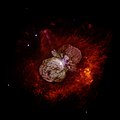Berkas:Eta Carinae.jpg

Ukuran pratayang ini: 600 × 599 piksel. Resolusi lainnya: 240 × 240 piksel | 480 × 480 piksel | 769 × 768 piksel | 1.025 × 1.024 piksel | 2.015 × 2.013 piksel.
Ukuran asli (2.015 × 2.013 piksel, ukuran berkas: 163 KB, tipe MIME: image/jpeg)
Riwayat berkas
Klik pada tanggal/waktu untuk melihat berkas ini pada saat tersebut.
| Tanggal/Waktu | Miniatur | Dimensi | Pengguna | Komentar | |
|---|---|---|---|---|---|
| terkini | 18 Desember 2017 09.41 |  | 2.015 × 2.013 (163 KB) | The NMI User | Reverted to version as of 14:14, 1 May 2008 (UTC) |
| 13 Maret 2017 14.45 |  | 3.000 × 2.998 (1,18 MB) | Leogorgon | larger file size | |
| 1 Mei 2008 14.14 |  | 2.015 × 2.013 (163 KB) | Vol de nuit | {{Information |Description=(NASA News Release) A huge, billowing pair of gas and dust clouds are captured in this stunning NASA Hubble Space Telescope image of the supermassive star Eta Carinae. Using a combination of image processing techniques (ditheri |
Penggunaan berkas
Tidak ada halaman yang menggunakan berkas ini.
Penggunaan berkas global
Wiki lain berikut menggunakan berkas ini:
- Penggunaan pada da.wikipedia.org
- Penggunaan pada en.wikipedia.org
- Star
- Eta Carinae
- Wikipedia:Selected anniversaries/March 11
- Wikipedia:Today's featured article/March 2017
- Wikipedia:WikiProject Wikipack Africa Content/Wikipedia:Showcase
- Wikipedia:WikiProject WikiFundi Content/Eta Carinae
- Wikipedia:Today's featured article/requests/Eta Carinae
- Wikipedia:Today's featured article/March 12, 2017
- Wikipedia:Main Page history/2017 March 12
- Wikipedia:WikiProject WikiFundi Content/Wikipedia:Showcase
- Wikipedia:Main Page history/2022 March 11
- Wikipedia:Main Page history/2022 March 11b
- Wikipedia:Main Page history/2023 March 11
- Wikipedia:Main Page history/2023 March 11b
- User:2003 LN6/sandbox/Eta Carinae variable
- List of luminous blue variable stars
- Penggunaan pada en.wikiversity.org
- User:Marshallsumter/Radiation astronomy2/Visuals
- User:Marshallsumter/Radiation astronomy2/Violets
- Stars/Astronomy
- User:Marshallsumter/Radiation astronomy2/Violets/Quiz
- Stars/Sun/Astronomy/Quiz
- User:Marshallsumter/Radiation astronomy/Courses/Principles/Hourly 2
- User:Marshallsumter/Radiation astronomy/Courses/Principles/Final quiz
- Draft:Original research/Io/Quiz
- Titan/Quiz
- Stars/Solar systems/Quiz
- Moon/Quiz
- Earth/Quiz
- User:Marshallsumter/Radiation astronomy/Colors/Quiz
- Volcanoes/Io/Quiz
- Stars/Violets
- User:Marshallsumter/Radiation astronomy2/Stars
- Stars/Violets/Quiz
- Penggunaan pada es.wikipedia.org
- Penggunaan pada fr.wikipedia.org
- Penggunaan pada hi.wikipedia.org
- Penggunaan pada it.wikibooks.org
- Penggunaan pada la.wikipedia.org
- Penggunaan pada mk.wikipedia.org
- Penggunaan pada ms.wikipedia.org
- Penggunaan pada my.wikipedia.org
- Penggunaan pada oc.wikipedia.org
- Penggunaan pada ru.wikipedia.org
- Penggunaan pada sk.wikipedia.org
- Penggunaan pada sr.wikipedia.org
- Penggunaan pada th.wikipedia.org
Lihat lebih banyak penggunaan global dari berkas ini.
